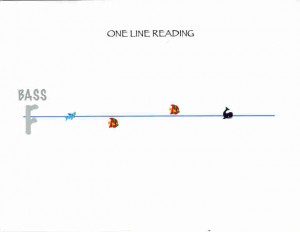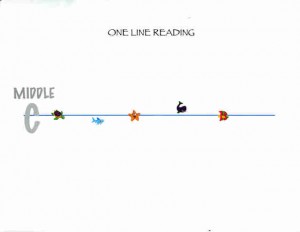PA Shorts: Not Exactly Pre-Reading
 My students have been full of questions about how to best help their beginning readers- especially those who look at the score as though it had lobsters crawling out of it. I myself recall answering, “Fly spot?” when my teacher asked me the name of a particularly pesky ledger line.
My students have been full of questions about how to best help their beginning readers- especially those who look at the score as though it had lobsters crawling out of it. I myself recall answering, “Fly spot?” when my teacher asked me the name of a particularly pesky ledger line.
My problem was that I didn’t understand the system underlying placement of notes. I was taught using the Middle C method and memorized locations on the staff and on the piano a few at a time while remaining blissfully unaware of how the Grand Staff actually worked. Since I need to see the forest and I like to understand how things relate, it made remembering notation cumbersome to say the least.
After a while, I realized that all I had to do was count up and down, forward or backward and I could figure out anything without having to flip back and forth or answer fly spot. Intervals? Well, I didn’t learn about intervals until college. Of course they would have made learning to read even easier.
So, how do I help my early readers succeed? I start small, really small. We start with one line drawn horizontally across the middle of a piece of 8.5 x 11 paper. I choose the name of the line. We identify the upper and lower neighbors (2nds if you want to introduce the term at that point). Then, I put removable stickers on the line and the student plays the “piece”. Next, I move one to a neighbor and we identify it. Then the student plays the new piece. I move another and plays. The student moves another and plays again. Sometimes the student makes a piece and I have to play it. We change the name of the line and play again.
I send the student home with instructions to change 3 notes and play the piece daily (and some extra stickers). To eliminate confusion, I give students a separate sheet for each different line note I want them to work on. I might give them  2 or 3 per week if they are doing well. In the examples on this page, I used specific note locations. However that is not a requirement. It doesn’t matter letter name you use because every note is a line note at some point on the Grand Staff. Matching actual locations to notes isn’t really necessary until you have 5 lines and spaces.
2 or 3 per week if they are doing well. In the examples on this page, I used specific note locations. However that is not a requirement. It doesn’t matter letter name you use because every note is a line note at some point on the Grand Staff. Matching actual locations to notes isn’t really necessary until you have 5 lines and spaces.
One students are really great at one line reading, we move on to 2 lines and then 3. After that, 5 lines is a breeze but id there are setbacks we go back to the activity for a week or so. This works so well in pairs or groups. Students love to try to trick another student and in so doing solidify what they themselves know. I had to make a rule that only 2 notes (sometimes only 1) can be changed per turn in order that everyone would be successful.
This activity isn’t exactly what we think of as pre-reading. That usually involves note names written in note heads or note heads moving vertically with no staff. Often the next thing in a book is treble then bass staff reading, a few notes at a time. One Line Reading is more of a transition from traditional pre-reading to full staff reading. It is an interactive, compositional game and students are drawn in to learning without realizing it. I’ve also had success using a modified form of this game with adults who are struggling with reading.
Try it and let me know how it goes.


